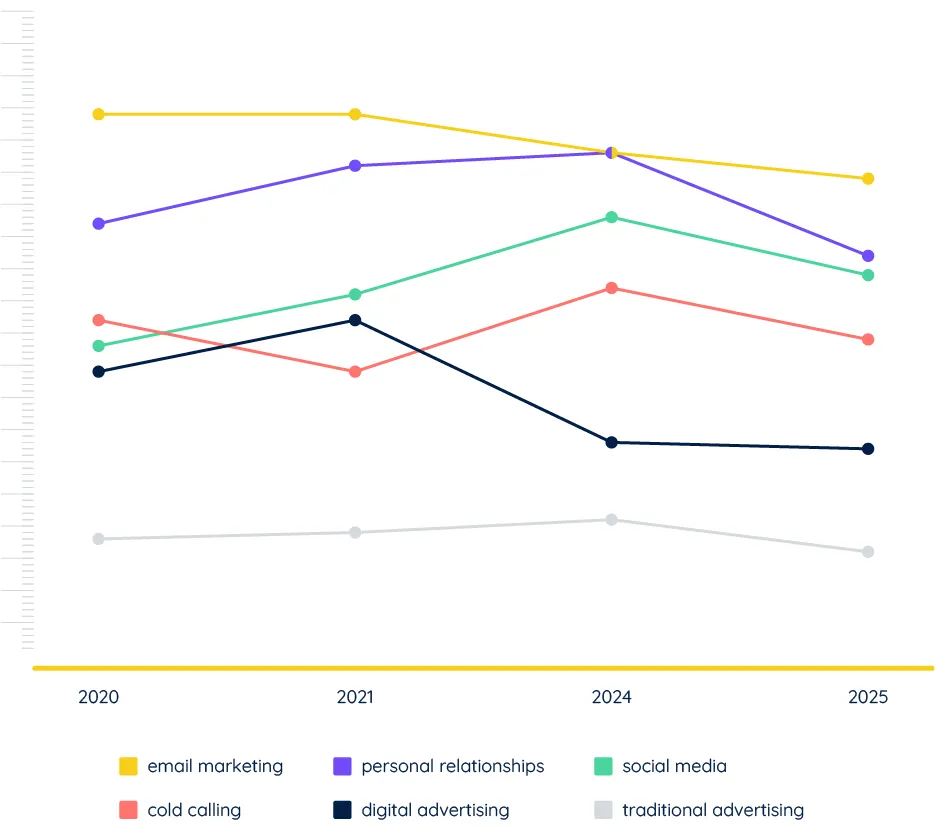

Since its inception, the DNA of CRE Report has been a cornerstone for insights, guiding commercial real estate (CRE) professionals through the ever-evolving landscape of our industry. It's more than just data; it's a temperature check that has reliably pointed us toward future trends by thoroughly understanding the role of brokers and marketers in the commercial real estate space. To celebrate ten years of DNA, let's look back at the top trends from the past, present, and future.
Looking back, it is evident that the technological wave predicted in 2017 made its mark. Eighty-nine percent of professionals believed tech use would catapult forward in the following years. By 2020, amidst the 5th anniversary of the DNA of CRE survey, brokers had welcomed additional tech tools into their arsenal. This tech adoption continued to shape the CRE landscape, with databases and CRM solutions like Outlook and spreadsheets evolving to more intricate systems tailored for CRE operations.
Property types also fluctuated in popularity. Office spaces, which dominated 2017-2019 as the most sold or leased, have since observed a shift in demand. Relationships remained king, with 73% of brokers in 2018 citing them as the beacon for winning business.
The initial predictions saw a significant shift towards artificial intelligence (AI) and virtual reality (VR) technology. These predictions glimpsed a CRE landscape heavily influenced by tech advancements to improve efficiency, marketing, and client engagement. Notably, the 2017 prediction of increased tech adoption has held true, as highlighted in the 2025 data, which revealed a notable upsurge in the budget allocated for tech tools, especially those incorporating AI and analytics.
Historically, office spaces dominated the CRE market, bolstered by a robust economic outlook and evolving work cultures. However, the forecasted demand experienced fluctuations due to unexpected global events, including the pandemic, which reshaped priorities towards more flexible and remote work environments. This shift caused a reevaluation of office space demand, with subsequent DNA reports validating these evolving trends and their impact on the sale and leasing of CRE properties. Office properties were the most sold in 2018, but by 2020, they had switched to second behind industrial properties until eventually leading the results in our survey for 2023. In comparison, this year's results show that industrial promptly back on top (22%), with retail coming in at a close second (21%).
Early predictions anticipated a significant shift in CRE marketing and prospecting tactics, expecting a boom in digital marketing, primarily through video and social media. These projections have proven accurate, as the leading marketing tactics brokers use are email marketing, social media and digital advertising. This year's results revealed that 58% of brokers used emails to help build and cultivate relationships. Still, traditional methods like regular phone calls and in-person meetings reigned supreme as the most effective ways to build new business.

Our DNA of #CRE reports offer a glimpse into the minds of brokers' everyday challenges and predictions. Ten years of data tell us that even though technology is changing how we work, creating strong relationships is still the most important ingredient for long-term success. After all, LinkedIn, one of the best social networks for connecting with industry professionals, has been brokers' top social media network since 2015.
Looking at past trends not only shows us what's happened before but also helps point the way forward. Most brokers are optimistic about the future, with 76% expecting increases in transactions across all categories. And those who stay informed about the latest in business and CRE trends tend to have a better shot at doing well in a competitive market.
Curious about this year's insights? Access our 2025 DNA of CRE report to unpack the full results.